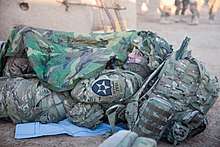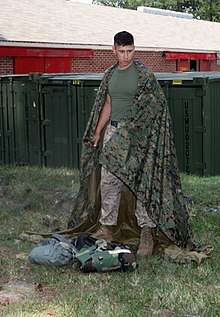Poncho liner
A poncho liner is a piece of field gear originating in the United States military intended to provide warmth in mild temperatures used as a field expedient sleeping bag when attached to the standard issue poncho by means of integral lengths of material which are looped through the poncho's eyelets.


A poncho liner is also known as a woobie,[1] a post-Vietnam term conjectured to have derived from the name for a child's security blanket in the movie Mr. Mom.[2]
Construction
Although it is unclear how this item originated, it was first fielded around 1962 to special forces troops in Vietnam. The poncho liner consists of two layers of quilted nylon encasing a polyester batting. There were tie-cords on the corners and side that could be tied through matching grommets on rain ponchos. They measured 62 x 82 inches. The intent was to field an item which was lighter and faster drying than the standard-issue Army Wool Blanket, which had essentially been rendered obsolete in the wet and tropical environment of Vietnam.
The first ones were Olive Drab on both sides and the earliest models featured squared corners. Around 1963, a second model was fielded which was made of WWII duck-hunter patterned parachute fabric. This model required the standard "center seam" because the fabric wasn't wide enough to produce the entire width. Later, the first camouflaged pattern was produced which was named, "ERDL Pattern." This stood for Engineer Research and Development Laboratories and the acronym became the common name for the pattern, which was enlarged somewhat in the 1980s to become the Woodland Pattern used on the BDU uniform and late 1980s poncho liners. The center seam was abandoned in the early 1970s because fabric could be produced in bolts that were wide enough that this sewing pattern was now obsolete.
Until the USMC produced their own Digital Woodland Pattern, most poncho liners were produced with the same pattern on both sides. The Marines decided to field one with Woodland Pattern on one side and a solid Coyote Color on the other. There are examples of improved models, which included high-tech 3M fillers (Thinsulate and the like), border and head zippers (there is no hole for one's head on standard issue poncho liners), and a variety of colors and patterns. Brigade Quartermaster, Inc. used to sell a zipper modification kit, which essentially codified and standardized commonly made modifications. Most recently, there have been models produced and issued in the Army's Universal Combat Pattern, the USAF's Environmental Camouflage Pattern, and Multicam/Scorpion II/etc.
Opinions
Opinions among the troops generally hold the poncho liner in high regard, as a very useful piece of equipment, light and packable yet reasonably warm. Even when soaking wet, the poncho liner wrapped around a soldier would trap body heat.[2] Many servicemen and women go through great lengths to find ways to keep their poncho liners as long as possible, even when they leave the service often upcycling or custom tailoring them into smoking jackets, hoodies, blanket coats or robes. The poncho liner found wide acceptance amongst US troops in Vietnam, providing just enough warmth for cool tropical nights but still being light and small. It is especially popular today in the age of 100-pound rucks and bulky Modular Sleep Systems.
References
- Powers, Kevin (11 September 2012). The Yellow Birds (Hardcover ed.). Little, Brown and Company. pp. 206, 208. ISBN 9781444756166.
- Officer, Angry Staff (18 August 2015). "Why The Woobie Is The Greatest Military Invention Ever Fielded". Task & Purpose. Retrieved 14 March 2017.